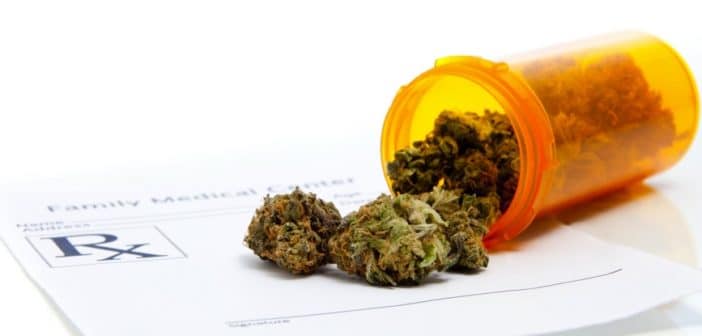 A cure to the national opioid epidemic may rest in an unlikely place. According to an eye-opening new study, researchers from Columbia University have discovered that states who legally allow medical marijuana experience a decrease in the abuse of opioids. Using federal car crash data, researchers found that a unique pattern emerged among the cases where opioids were involved. “States that passed a medical marijuana law during this period saw a reduction in opioid involvement in fatal car accidents, relative to states without such a law,” The Washington Post reported. The study, conducted by Columbia University’s Mailman School of Public Health, noted that the opioid decrease was most notable in drivers aged 21 to 40 years—otherwise known as “the age group most likely to use medical marijuana where it’s available.” The connection is as surprising as it is potentially game-changing for the country’s opioid epidemic.
A cure to the national opioid epidemic may rest in an unlikely place. According to an eye-opening new study, researchers from Columbia University have discovered that states who legally allow medical marijuana experience a decrease in the abuse of opioids. Using federal car crash data, researchers found that a unique pattern emerged among the cases where opioids were involved. “States that passed a medical marijuana law during this period saw a reduction in opioid involvement in fatal car accidents, relative to states without such a law,” The Washington Post reported. The study, conducted by Columbia University’s Mailman School of Public Health, noted that the opioid decrease was most notable in drivers aged 21 to 40 years—otherwise known as “the age group most likely to use medical marijuana where it’s available.” The connection is as surprising as it is potentially game-changing for the country’s opioid epidemic.
What The Study Said
Columbia researchers analyzed car fatalities across 14 years (from 1999 to 2013) and noted the types of drugs found in the drivers’ systems. There’s an unmistakable connection between the states with medical marijuana laws and the number of people who use opioids. The study’s results, published in the American Journal of Public Health, “adds to a growing body of evidence suggesting that chronic pain patients may substitute marijuana for prescription painkillers in states where the option is available.” In 2014, researchers similarly found that “medical cannabis laws are associated with significantly lower state-level opioid overdose mortality rates.” It’s also part of a trend that researchers believe spells the beginning of the end for opioid use, as the study’s authors argue that they “expect the adverse consequences of opioid use to decrease over time.”
Out of nearly 70,000 drivers who died in car crashes, the study found that “approximately 42 percent were fatally injured in states that had an operational medical marijuana law, 25 percent died in states before an operational law went into effect, and 33 percent died in states that had never passed a medical marijuana law.” Once medical marijuana laws went into effect, investigators found that the number of opioid-positive drivers killed in car crashes began to decrease. The conclusions dovetail with similar studies that found painkiller prescriptions “declined significantly in states that passed medical marijuana laws,” The Washington Post said. In fact, the story claims that that not only do medical marijuana states see far fewer painkiller-related deaths, but access to medical marijuana dispensaries are “linked to declining rates of opiate overdose and death.” While marijuana and opioids have completely different effects on the human body, they both manage pain. As one Esquire story pointed out, though, those differences speak for themselves: “Opioids were responsible for 28,000 overdoses in 2014. Marijuana was responsible for zero.”
Killing the Competition
The Columbia study couldn’t come at a more controversial time. Just last week, the pharmaceutical company Insys Therapeutics Inc. came under fire for trying to torpedo marijuana legalization. Insys, which sells fentanyl (the same synthetic opioid that killed Prince earlier this year), “donated $500,000 toward defeating a ballot initiative that would make recreational use of marijuana legal under Arizona law.” The manufacturer is “also currently developing a synthetic version of tetrahydrocannabinol (THC), the main psychoactive ingredient in cannabis, to treat cancer-related nausea and vomiting,” one site said.
The company is now being investigated for pushing the “fast-acting and highly-addictive” drug Subsys on doctors, hoping that what’s intended to be a cancer med is used elsewhere. The Illinois Attorney General filed a lawsuit against Insys, claiming that the firm’s “desire for increased profits led it to disregard patients’ health and push addictive opioids for non-FDA approved purposes.” The half-million dollar donation, which stands as “one of the biggest-ever single donations to anti-legalization cause,” only cements its position to quash the competition. “It’s not the first time pharmaceutical companies have helped bankroll the opposition to marijuana reform,” journalist Lee Fang observed. “The Community Anti-Drug Coalition of America, a nonprofit that organizes anti-marijuana activism across the country, has long received corporate sponsorship from Purdue Pharma, the makers of Oxycontin, and Janssen Pharmaceuticals, another opioid manufacturer.” Alcohol industry groups have also made “significant contributions to anti-pot legalization efforts in Massachusetts and Arizona.”
What the Future Holds
“As states with these laws move toward legalizing marijuana more broadly for recreational purposes, future studies are needed to assess the impact these laws may have on opioid use,” the study’s lead author, June H. Kim, said. Still, it’s hard to refute the initial findings regarding marijuana’s impact over opioids. Interestingly, that trend doesn’t apply for all ages. “The toxicological testing data for fatally injured drivers lend some suggestive evidence that supports the substitution hypothesis in young adults, but not in older adults,” said the study’s senior author. That’s probably because “minimum age requirements restrict access to medical marijuana to patients age 21 and older, and most medical marijuana patients are younger than 45,” Kim contended.
Currently, medical marijuana is legal in 25 states and the District of Columbia. (California was the first state to pass a medical marijuana law.) Each state carries its own set of restrictions when it comes to the drug, though the Drug Enforcement Administration (DEA) still isn’t budging. Just this past August, the DEA refused to relax its position on the Schedule 1 controlled drug. For the time being, it seems to be as simple as the wording: marijuana has “no currently accepted medical use” and carries a “high potential for abuse.” The Columbia study challenges long-standing biases and questions about the drug’s value. If nothing else, the study’s findings suggest that marijuana may be the one thing that can clear the cloud of opioid abuse hanging over our country.
Sponsored DISCLAIMER: This is a paid advertisement for California Behavioral Health, LLC, a CA licensed substance abuse treatment provider and not a service provided by The Fix. Calls to this number are answered by CBH, free and without obligation to the consumer. No one who answers the call receives a fee based upon the consumer’s choice to enter treatment. For additional info on other treatment providers and options visit www.samhsa.gov.




